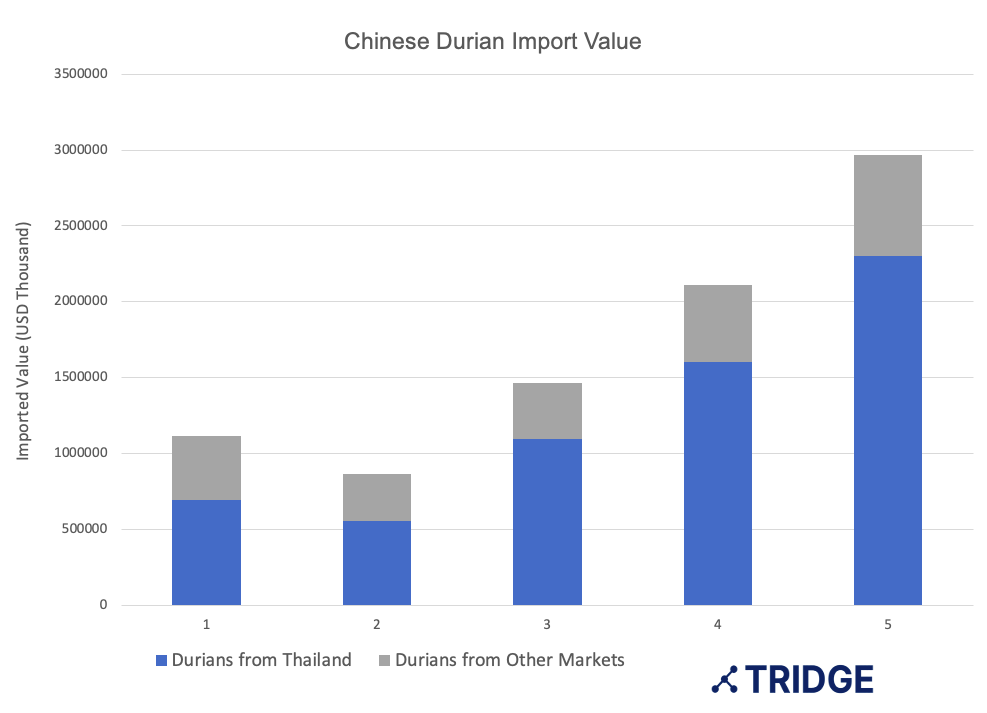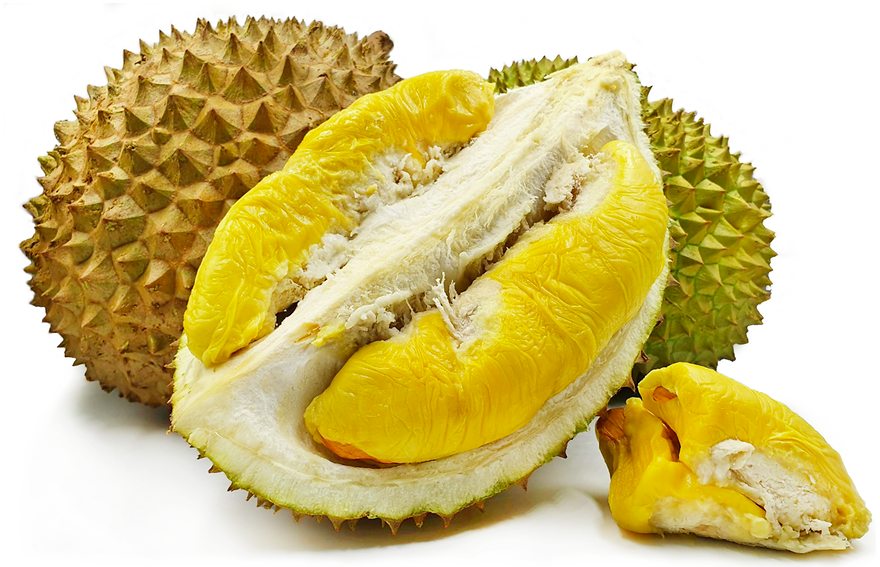Malaysian Durian Doubles its Export Value over 4 years

Two main countries currently dominate the global durian trade; while China dominates the increasing demand on imports, Thailand dominates the supply as the largest exporter. In 2020, Thailand accounted for 45% of the global share, while China, including Hong Kong, accounted for 96% of the global import share. China’s growing demand for durians is driving the accelerated growth of the market. However, over recent years, countries like Vietnam and Malaysia have continuously increased their share in the Chinese market and are now strong contenders to Thailand in the supply of fresh durians.
Accelerated Demand from China has created Fierce competition
Accelerated demand for diverse durians has increased imports in China and boosted Hong Kong’s re-export operations. Hong Kong re-exports 90% of its durian imports to other markets, with mainland China receiving the majority. In 2020, mainland China imported USD 2.3 B in fresh durians from Thailand, the only Asian country allowed to export directly to China. However, Hong Kong also increased its imports by 31% to 628 M, and its re-exports by 28.5% to USD 585.5 M. Thus, there is an increasing market in China for durians that are not of Thai origin.

Source: ITC Trade Map
The increasing demand for other types of durians is well known by Thai growers. According to Petchpimol Vithyanond, Tridge’s representative in Thailand, Thai durian growers are aware of the expansion of supply in other countries and expect a substantial decrease in their market share in China. Countries like Myanmar, Malaysia, Vietnam, and Laos will be increasing their share as they are starting to expand durian farms a couple of years ago.
In the case of Malaysia, farmers have come to realize that it is one of the most profitable fruits for them and exporters. As a result, the harvest area for durian in Malaysia has been expanding throughout the past four years while new varieties have been developed, such as the Malaysian Musang King. This variety, which has become extremely popular in China, also has the highest Brix levels from all durian varieties with a Brix level between 39 and 44, which means it has a high-profit return for growers.
Musang King; Malaysia’s Key Entrance to China
Since 2019, Malaysia was allowed to export only Frozen Whole Durians aside from frozen pulp. In terms of demand, Chinese consumers have been consuming more frozen whole durians in the last 5 years because durians that are wholly frozen could be harvested at full maturity and still be at the optimal quality level by the time these arrive at the destination port. On the other hand, fresh durians are harvested at 80% maturity and experience quality issues during transportation.
According to the Royal Thai Consulate-General in China, the Malaysian Musan King variety has entered the Chinese marketing channels since October last year. Since then, the Malay durian is fast becoming popular in China and has driven the growth of durian exports. According to Malaysia’s Ministry of Agriculture and Food Industries, Hong Kong will increase its Malay durian imports in 2021 by 176% from the previous year, reaching USD 13.8 M and will account for 40% of the total exported value in the year.
In 2019, the Musang King production volume was between 20K to 25K tons and is expected to reach in the next five years to 40K-50K tons. The retail price of the Musang King has also risen by 300% after China began importing whole durians from Malaysia. The price went up from USD 1.90 per KG last year to USD 9.59 per KG this year, with premium varieties such as the Musang King, Ochre, and Sultan sold out.

Malaysian Musang King Variety/ Specialty Produce
According to Hanizah Rasad, Tridge´s Engagement Manager in Malaysia, apart from the Musang King, Malaysia will also add the increasingly popular export variety D24 in China. Although the D24 is cheaper than the Musang King, it cannot match the Musang King's taste. D24 is widely exported in terms of paste and dried for use in cooking. Exports of this variety are expected to increase 25% in 2022 to China.
Outlook for the Malay Durian in the Chinese Market
Exports of Malaysian durians are forecast to maintain a rapid growth rate in the near future with substantial support from the government. The durian market in China is composed of a large diversity of brands, large price differences with significant market fluctuations, and irregular quality levels. For Malaysian durians, there are still significant opportunities in the Chinese market for proper brand establishment. If Malaysia is able to compete in quality and price with common Thai durian found in the Chinese market, it will have an opportunity to keep increasing its share. It might be able to surpass Vietnam as the second-largest supplier to China.
Malaysia’s main trading partners for durians have traditionally been Singapore, Hong Kong, and the US. However, any other markets have had such an accelerated growth as the Chinese market via Hong Kong or Taipei. It is estimated that the global trade of durian will reach USD 35 B by 2030, with China as the main global trading partner. For Malaysian exporters, it is now very clear which market to focus on to keep the rapid growth they have been experiencing.
Sources:
- 27 Group. "Outlook of Durian Industry in Malaysia – Second Largest Exporter of Durian in the World."
- Produce Report, 马来西亚榴莲出口额5年翻一番,中国为其最大市场
- Tridge Local Insight, "Fierce competition between Thai Durian growers and decreased market share in Chinese market share is expected."
- Tridge Analysis. Durian Battle for the Chinese Market.



